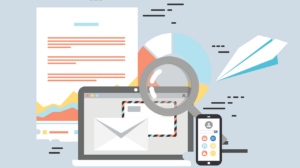Wondering how to make your infographics stand out from the rest? We bring you a handy guide to create engaging and outstanding infographics that will engage and educate your audience.
If you truly want to create an impact and engage your audience in 2021, you need to start adding visuals in your content strategy.
Think of infographics as assets that you need to add to the content marketing mix. But how do you make them stand out from the rest?
During the past few months since I started my own blog, I tried my hand at infographics. Surprisingly, most of the bloggers I reached out to for guest posts loved the idea of an infographic.
Here’s what I’ve learned so far.
Understanding Infographics
Infographic = Information + graphic
In other words, a collection of minimal text, charts and imagery that give an easy understanding of the topic is known as an infographic.
It can be a long webpage or an image that includes graphs, charts and other data to give you all the information at a single glance.
Types of Infographics
There are different types of infographics. Each of them is defined by its goal, the content and story it’s telling. Here are the most common types of infographics:
Information design
When you organise a concept to tell a story, you’re making an information design infographic. You can use flow charts, timelines, graphs and charts.
Data visualizations
Includes data points from trends or surveys. In simpler words, it means making data visual, easy to retain and understand.
Editorial infographics
They’re most commonly used by publications (such as the New York Times) and include more copy than any other type of infographic. Here, graphics are mixed with data points in a long-form to tell a story.
Gathering Data
You’re intrigued by the idea of creating an infographic and want to give it a shot. But how do you gather data? Here’s what you need to do:
Determine the Type of Data You Need
Sit down and determine the kind of data you wish to share in order to create a great story. Once done, start looking for that data in published journals, online or from your own studies or surveys.
Customers’ Data
The number one untapped resource is proprietary data. Look for customers who’re willing to share their success stories (or failures). This will not only make your story unique but will also increase your engagement rate.
Additionally, it makes you look more credible when you associate your brand with authentic sources.
Cite Industry Leaders and Experts
Including quotes from experts and leaders is the simplest way to make your infographic look more credible.
Please remember to confirm the source. It can cause more harm to quote something a leader didn’t say. Citing sources will also help you seem more reliable.
Using Your Own Research
If you’re using your own research, it’s important to understand that it needs to be unique in order to be engaging. Mix data points with graphics in a manner that creates value.
Tools to Collaborate, Compile, Organize and Research
For all the infographics I’ve created so far, I’ve used the following tools:
- Google Docs
- Scrivener: it’s a useful app for organizing, compiling data, writing and researching.
- Good Notes: it’s a great tool to create mockups, draw and shape your ideas or simply write down your notes.
- Evernote: it’s a free tool that allows you to seamlessly share, collaborate, research notes and web content.
Designing your Infographic
You’re ready with your research but how do you design an eye-catching infographic?
Define Your Audience
Before you begin the actual designing, take a few minutes to define your audience.
Keep the following questions in mind:
- Who is my audience?
- How will my infographic make them more informed?
- What am I including in my infographic that’ll add value for my readers?
Craft an infographic once you have the answers to these questions because they will help you create the right story.
Determine the Infographic Style
Choose an infographic style based on what your audience will prefer. Also, take into account the kind of data you’re planning to share in your story.
Does it include more text? Does it include a lot of graphs and charts? Or is it a mix of both?
Setting realistic expectations early on will help you create a meaningful infographic.
Create a Mockup
This can either be done by you or your designer. Ideally, you want to create a few mockups so that you can determine and use the best one.
You can use the following tools to create a wireframe:
- Pencil and paper
- Adobe XD
- Balsamiq
- Sketch
Determine the Main Success Metric
What’s your goal with the infographic? Converting sales? Increasing readership?
Whatever it is, determining the ultimate measure of success early on is crucial.
Conversion points will depend on where you place the infographic – a landing page, email or a blog page.
Choose wisely because the success of your infographic largely depends on it. Take into account your original goal and the stage of the buyer journey you are in.
Use an Engaging Headline and Compelling Pitch
Once your infographic is ready, it’s time to get traffic to it.
You have a number of choices so as to where to place your infographic including emails, landing page, blog page or even a third-party platform like Hubspot, Eloqua or Marketo.
Regardless of what you decide, you must have a compelling headline that not only attracts a lot of eyeballs but also gives an idea of what your infographic is all about.
A supporting pitch will keep your readers engaged.
Finding and Sharing Your Infographic
It should be easy for your readers to find and share your infographic. The key is to optimise it so that you can get the maximum number of links.
Platforms to Create Infographics
A lot of web-based platforms will help you create infographics at scale.
Adobe Spark and Canva are best for static infographics. With a variety of templates, you can create an infographic in no time.
However, if you wish to create something unique, hire a designer who has an eye for detail and is well-versed with Adobe Illustrator.
The Takeaway
To summarize, you need to keep the following points in mind to up your infographic game:
- Be informative: remember it’s all about educating and providing value to your readers.
- Show, don’t just tell: keep your infographic visually attractive to draw the attention of your reader. Remember, the less text, the better.
- Logical Hierarchy: structuring the data is crucial. Strategize and make sure your headline, pitch and story closing are compelling.
- Pivot as needed: Don’t be so hard on yourself. It’s alright if you don’t create a fabulous infographic in one go. Change course and experiment a few times to create something great.





